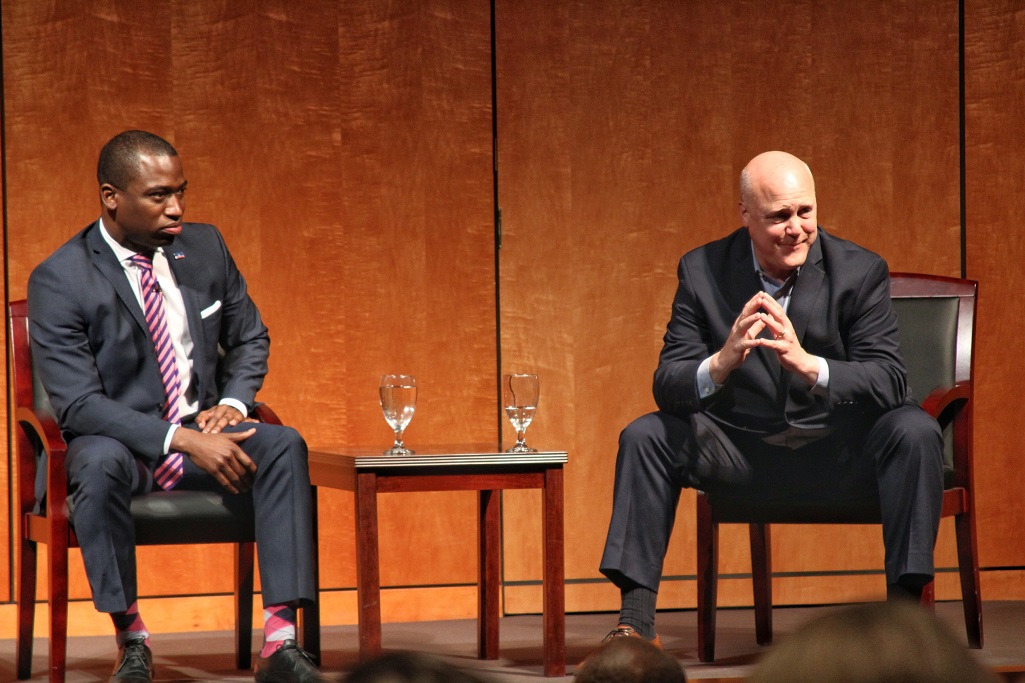In his meeting with Mayor Levar Stoney this week, former New Orleans Mayor Mitch Landrieu challenged Richmonders to consider the continued impact of Confederate monuments on our city’s image and reputation.
It was a meeting of the Mayoral minds on Tuesday, as Richmond’s Mayor Levar Stoney and New Orleans’ former mayor Mitch Landrieu engaged in thoughtful discussion at the Virginia Museum of History and Culture.
About 100 people listened as Mayor Stoney recounted Richmond’s struggle with Confederate iconography and race relations in Richmond, while Landrieu recalled his experience presiding over the removal of his city’s Confederate monuments.
“We created things with regard to race, and we can’t fix things without regard to race,” Landrieu said. “Our public spaces speak to who you are. It’s intended to say something, especially monuments and statues.”
At the crux of this discussion, Landrieu asked of Richmond: What do we want to be known for?

In 2015, Landrieu called for the removal from prominent public display of four monuments in New Orleans, three of Confederate generals and one memorializing a violent coup of the state government by the Crescent City White League. All the monuments in question were removed by May 2017, although not without two years of legal battles, public criticism, and even threats against Landrieu’s life. His opponents criticized him for a lack of transparency during the process.
In a discussion moderated by Julian Hayter, an associate professor of Leadership Studies at the University of Richmond and member of Stoney’s Monument Avenue Commission, Stoney and Landrieu discussed racism in the South, and how to reconcile its history with its people.
“We can’t ignore the fact that we’ve had an ugly history,” Stoney said.
Last year, Stoney’s Monument Avenue Commission recommended removing the Jefferson Davis monument, while adding context to the other four Confederate statues.

Landrieu’s charismatic, animated oration offered blunt, third-party observations about Richmond’s race relations and Confederate iconography. Ultimately, he posited Richmond must find a solution that is right for Richmond, regardless of any other city’s actions.
“There is a difference between remembrance and reverence,” Landrieu said. “Remembrance is what you always want to do, so you don’t let it happen again. Reverence is honoring something, so you might be able to do it again.”
Stoney stated that if it were in his legal power to remove them, the statues would be gone. He also said that while removing the statues were important to many Richmonders, his real concern was providing reparations to deprived communities negatively affected by past racial injustices.
In this context, reparations are not about putting cash directly in the hands of disenfranchised people; they are about funding schools that never get funded, putting money in parks and community spaces, and reforming previously exclusive places into safe, inclusive space. They are about allowing a city’s architecture, aesthetic, art, and monuments to reflect the citizens it houses.
“Does that man standing on top of that thing send a message that you are welcome here, and that we want you to be here?” Landrieu said. “I was the mayor of a majority African American city, and I was the mayor of a city that has a monument that doesn’t represent our city. We decided in our specific circumstance, it was the best thing to do. What you cannot do is forget who put it up and why they put it up.”
Landrieu urged Richmonders to consider that a single plaque is not contextualization. To provide an adequate frame of reference would require the statue of a “lynched man” to reside next to Jackson and Lee.

It may be prudent to point out that by erecting those statues, we are actually disobeying the wishes of a dead man, one who is at the epicenter of this entire debate: Robert E. Lee.
“I think it wiser,” the retired Lee once wrote of a proposed Gettysburg memorial in 1869, “not to keep open the sores of war but to follow the examples of those nations who endeavored to obliterate the marks of civil strife, to commit to oblivion the feelings engendered.”
After the Civil War, Lee swore allegiance to the Union, publicly denounced any sentiment toward Southern separatism, affirmed the need to move on, and believed that by keeping those images alive, so would the sentiments of division live on and thrive.
Mayor Landrieu asserted similar sentiments in asking us to question that reverence associated with Confederate iconography. We have an entire avenue on which we all but worship the leaders of a failed nation, then act as if this is a presentation of historical events rather than a deep respect and longing for that failed nation.
“People are watching y’all,” Landrieu said. “I want to ask, do y’all want to be known for that?”
America has a history of building grandiose, reverent monuments to what Lee described as “civil strife,” and compared to those left by other countries throughout the 20th century after their own national conflicts, it calls us to examine how Americans display memorials to bloodshed.

Our memorial to the lives lost in the 9/11 attacks has turned into a multibillion dollar shopping mall, the Westfield World Trade Center. The American cemetery in Normandy, France, honoring those soldiers lost to WWII, boasts a $30 million welcome center, a chapel, and a 22-foot statue. Compared to the somber, understated French, German, and Canadian cemeteries in the same area, America’s message is clear: We are dominant, we are proud, we are strong, we are to be seen.
And while direct, this isn’t entirely inappropriate. Our culture differs from European countries in that we are opportunistic, and have a free-market capitalist economy. We honor our tragedies, but we simultaneously find a way to make money from them. We are clever, competitive, and fierce. Albeit occasionally sporting a tone-deaf quality, it is true to our nature. For better or worse, it is what we are known for. And, ultimately, even the aforementioned monuments honor soldiers and innocent lives lost to tragedy and terror, rather than the lost cause for continued human oppression that the figures on Monument Avenue commemorate.
And so, Mayor Landrieu’s challenge to Richmond resonates. In the wake of his visit, we must ask ourselves the same question he asked of us: What do you want to be known for? And how will you display it?
Top photo by John Donegan



